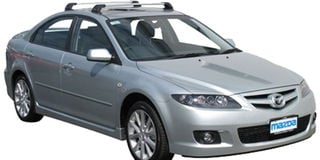Mazda6 takes on Premio

The Mazda6 was sold as Mazda Atenza in Japan and China. This was the first generation that was in production from 2002 to 2008. Body styles were offered in sedan, hatchback and estate or station wagon versions.
What you need to know:
Mazda is one of the respected car brands out there but one that is some how ignored in Uganda. Granted, there are some Ugandans driving Mazdas but when it comes to Japanese cars, Toyota leads. Paul Kaganzi weighs up the 2002 Mazda6 against the 2002 Toyota Premio.
BACKGROUND
Mazda and Toyota decided to shed off utilitarian (practical and cheap) features by up scaling their compact sedan cars into more luxurious and sporty vehicles. Honda upgraded the Accord while Ford redeveloped the Mondeo and Opel redressed the Vectra. In 2001 Mazda and Toyota revamped declining sales by replacing the ageing but practical Mazda 626 (Capella) and Toyota Corona with the more refined, luxurious and faster Mazda 6 also called Atenza in Japan and Toyota Premio also called Avensis in Europe. Mazda 6 offered more nimble and sprightly petrol engines with 1.8, 2.0, 2.3 and 3.0 litre V6 capacity, while Premio offered the 1.5, 1.8 and 2.0 litre power plants. Let us put the popular used 2002 2.0 litre petrol Mazda 6 in the ‘red corner’ and the equivalent Toyota Premio in the ‘Blue corner’ and see which one throws a heavier punch.
PERFORMANCE
Mazda6’s LFVE MZR and Premio’s 1AZ FSE 2.0 litre petrol engines have very efficient technology. These two engines feature electronic fuel injection with Double Overhead Camshaft (DOHC) drive trains lifting 16 valves and Variable air intake technology which makes them ‘fast and furious’ with impressive fuel economy. When you put the two ‘pugilists’ head to head on the flat smooth tarmac of Lyantonde on Masaka-Mbarara highway, you will tell the difference.
The more nimble and sprightly Premio which takes 9.4 seconds to accelerate from 0-100 kilometres per hour inches forward and departs from the Mazda6 which takes 11.1 seconds to accelerate from 0-100kph. When you look under the bonnets of these two cars you will understand why. Mazda and Toyota used different fuel delivery systems in both cars. The superiority in power delivery and economy of a conventional internal combustion engine can be determined by the prompt delivery of an optimum fuel air ratio, if all other factors are equal.
HANDLING
Toyota built in the Premio the Direct four (D4) fuel delivery technology where petrol is highly pressurised, and injected in the right amounts via a common rail fuel line directly into the combustion chamber of each cylinder. This gives the Premio prompt bursts of power at more economical lower engine revolutions (110 Kilowatts/ 148 horsepower @ 5,700rpm) unmatched by Mazda6’s less efficient multi point fuel injection via the intake port which delivers less power at higher and more fuel costly engine revolutions (104 Kilowatts / 141 horsepower @ 6,000 rpm).
No wonder the Premio covers 15.15km per litre of petrol while the Mazda6 delivers 14.5km/l. The Mazda6 and Premio are equally a joy to drive because of their good road manners and excellent body control. Both rivals have in-built front independent suspension with McPherson struts and coils while the rear axles are kitted with control blade multi-links with coil spring and dampers. Mazda 6’s wider, longer and lower profile gives it a firmer grip of the tarmac during high speed manoeuvres with less coefficient of drag or wind resistance. On the other hand, Premio has a firm and heavy steering while Mazda6 feels light and unsettled during extreme steering.
STYLE & SAFETY
The Mazda6’s stylish and sleek shape is a winner from the start. Its long and elegant silhouette blends well with its beautiful lights (which are not very clear at night). The Premio looks like a bridal escort when parked next to the Mazda6. Mazda will be any driver’s pick when they sit inside and enjoy the supportive and extremely comfortable seats. Compared to Premio, Mazda6 is roomier and feels open or less enclosed. Although Premio offers bur walnut wood impression in its interior it is just plastic and not the real deal. Both cars offer CD entertainment, air conditioning, electric windows and mirrors. Premio’s boot space is slightly bigger but passenger comfort is paramount.
Mazda also raises the safety stakes with its ‘Triple H’ new crash safety engineering which channels front, rear and side impact forces into three H shaped sections of the body structure. This earns it the four star NCAP crash rating. Both Mazda6 and Premio have passive driver aids to enhance safety such as Anti lock brakes with electronic brake force distribution (EBD) and traction control. Front dual airbags, side airbags (for the Mazda) and child seat harness and rear door child lock facility are also available.
RESALE VALUE
Premio rides on the popularity of Toyota on the Ugandan market which ensures easier access to quality new and used parts available with local parts dealers. Mazda is a brand that is just getting popular but has few parts dealers for fast or slow moving parts. The engine technology in both cars requires diligent regular routine maintenance with high grade lubricants and genuine parts. Premio will have a better resale value because of the parts situation. However, its interior centre console, window switches and side mirror glasses are a target for petty thieves and house burglars.
VERDICT
Mazda6 scores four stars for better handling, design or styling, comfort and a good safety record. Premio scores four star points for better engine performance, good safety features, better availability of parts and resale value. We have a tie.




